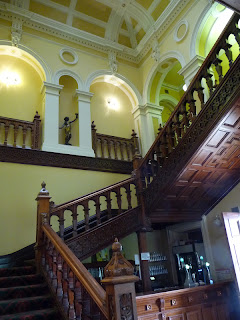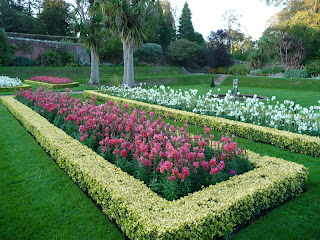We had an absolutely gorgeous day today! Blue skies and warm temperatures the entire day. Could not have asked for a better day. Only one problem: I felt terrible all day long!! It was all I could do to put one foot in front of the the other. We were supposed to go on a hike today but there was no way I was even gonna try it!
Downtown Belfast is very busy in the mornings! After breakfast, we walked across the street to get some type of medicine to try and help me feel better. It helped some.
Today, we made a big circle from and back to Belfast, going out on the Ard's Peninsula.
Belfast Castle was our first stop of the day. Belfast Castle is set on the slopes of Cavehill Country Park, Belfast, Northern Ireland in a prominent position 400 feetabove sea level. Its location provides unobstructed views of the city of Belfast and Belfast Lough. The original Belfast Castle, built in the late 12th century by the Normans, was located in the town itself, but was burned down in 1708. The building that stands today was built from 1811–1870. The castle boasts an antiques shop, a restaurant and visitors centre and it is a popular venue for conferences, private dining and wedding receptions. (Wikipedia) There were no functions at the castle today, so we were able to walk through it.
According to legend, Belfast Castle is safe as long as there is a (preferably white) cat residing there. This myth led to the creation of the "Cat Garden". It boasts no less than nine "cats" for visitors to discover.
We could only find seven of the nine cats...
We could only find seven of the nine cats...
The gardens at the castle were beautiful!
Bangor Castle Walled Garden was designed by the Ward family in the 1840s. It was never open to the public and was considered by many as a secret garden! North Down Borough Council have restored this beautiful garden and it was officially opened as a visitor attraction in April 2009. We didn't spend a lot of time there. Just snapped a few pictures and got directions to the castle.
Bangor Castle in Bangor, Northern Ireland was completed in 1852 for The Hon Rober Edward Ward. This imposing building is not so much a castle as an elegant mansion in the Elizabethan-Jacobean revival style. It has 35 bedrooms and incorporates a huge salon for musical recitals. It is now known as the Town Hall. North Down Borough Council now sits at the Castle. There was actually a wedding going on while we were there. You can see them at the door...
Donaghadee is situated on the Ards Peninsula, approximately seven miles north east of Newtownards, on the Irish Sea coast. The town boasts a long seagoing history, therefore it is not surprising that it still maintains a special relationship with the sea, proving very popular with water enthusiasts, anglers and those who simply like to be beside the seaside. From Donaghadee, visitors have the opportunity to enjoy spectacular views across the Irish Sea, where on a clear day you can see all the way to Scotland.
Donaghadee Castle
In the Harbour is Donaghadee's impresive lighthouse, which was built in 1836 and was the first lighthouse in Ireland to be lit by electricity. One of the most prominent features of teh town is the Motte, or the Moat as it is known. The moast dates back to 1818, when it was used to house expolsives used in the construction of the harbor. Today it is part of a little park, giving views across the town and across the sea towards the Copeland Islands. (discovernorthernireland.com)

Ballycopeland Windmill is a functioning windmill located one mile west of Millisle, County Down. It is a typical Irish stone tower mill, with a moveable cap turned by means of an automatic fantail, ensuring that the sails always faced into the wind. The plastered and white-washed tapering tower is a landmark in that area and the last remaining windmill of more than hundred mills in County Down. It is estimated that Ballycopeland windmill was built around the 1780s or 90s. (Wikipedia)
Scrabo Tower is located to the west of Newtownards in County Down. The landmar, which is visible from most of north Down, was built on a volcanic plug above the town in 1857 as a memorial to Charles Stewart, 3rd Marquess of Londonderry who was one of the Duke of Wellington's generals during the Napoleonic Wars. the view from the hill and summit of the tower extends across Strangford Lough, scattered with its many islands, to the Mountains of Mourne and the Scottish coast. The tower houses two floors of displays and a climb of 122 steps takes the visitor to the open viewing level. Scrabo Country Park is always open, admission to the park and the tower is free. (wikipedia)
Of course, after we slimbed u the hill and were read to climbe the tower, we got to the door at it was padlocked. The sign bleow said it was "always" open... hmmmm... I guess that was okay because it was rather hazy and we probably couldn't have seen very far.

Mount Stewart is an 18th century house and garden in County Down, owned by the National Trust. Situated on the east shore of Strangford Lough, a few miles outside the town of Newtownards and near Greyabbey, it was the home of the Vane-Tempest-Stewart family, Marquesses of Londonderry. The house and its contents reflect the history of the Vane-Tempest-Stewarts, who played a leading role in British and Irish social and political life. (wikipedia)
The photos of the house below are actually the side/back of the house. The front of the house was very "ugly" with no landscaping, just a huge gravel area -took one picture that was too blah to share on here.
Grey Abbey, a Cistercian abbey-monastery, dates from 1193. Architecturally it is important as the first fully gothic style building in Ulster; it is the first fully stone church in which every window arch and door was pointed rather than round headed. Tradition says that Affreca founded the abbey in thanksgiving for a safe landing after a perilous journey at sea. (wikipedia)
Portaferry is a small town in County Down at the sourthern ed of the Ards Peninsula, near the Narrows at the entrance to Strangford Lough. It has its own small marina, the Portaferry Marina. A passenger/car ferry service operates daily between the villages of Portaferry and Strangford, less than a mile apart, conveying about 500,000 passengers per year. Commercial fishing for clams and king prawns and the farming of oysters and mussels takes place within the confines of Strangford Lough. (wikipedia)
There was a castle up on the hill. Portaferry Castle is a small tower house in Portaferry overlooking the harbor. It was build in the 16th century.
Strangford Castle is a castle on a height overlooking the harbour in Strangford, County Down. It was probably originally built in the 15th century but most of present building dates from the late 16th century.
Castle Ward is situated in a stunning location overlooking Strangford Lough. The lawns rise up to the unique 18th century house and its Gothic façade. This fascinating house features both Gothic and Classical styles of architectural treatment, internally and externally. Inside the beautiful 820 acre walled demesne you will find an exotic sunken garden and paths that wind their way through woodland and suddenly open onto the quiet shores of the Lough. (discovernortherireland.com)
It was a little "creepy" when we got there because there was NO ONE around!! We had the entire place to ourselves. For some reason it was closed but you could still walk around the grounds. I did not like being there by ourselves - it kind of freaked me out!
Old Castle Ward lies in the grounds of the Castle Ward estate, north west of the village of Strangford. Old Castle Ward was built in the late 16th/early 17th century. Old Castle Ward is a 3-story tower house built of split stone rubble.
We ended our day back in the busy, busy city of Belfast, Northern Ireland. We are staying at the Jury's Inn again tonight. We ate dinner in the hotel dining room. Then it was back to our room to relax and get ready for our last day in Ireland.













































Great pictures! Thanks for sharing.
ReplyDelete